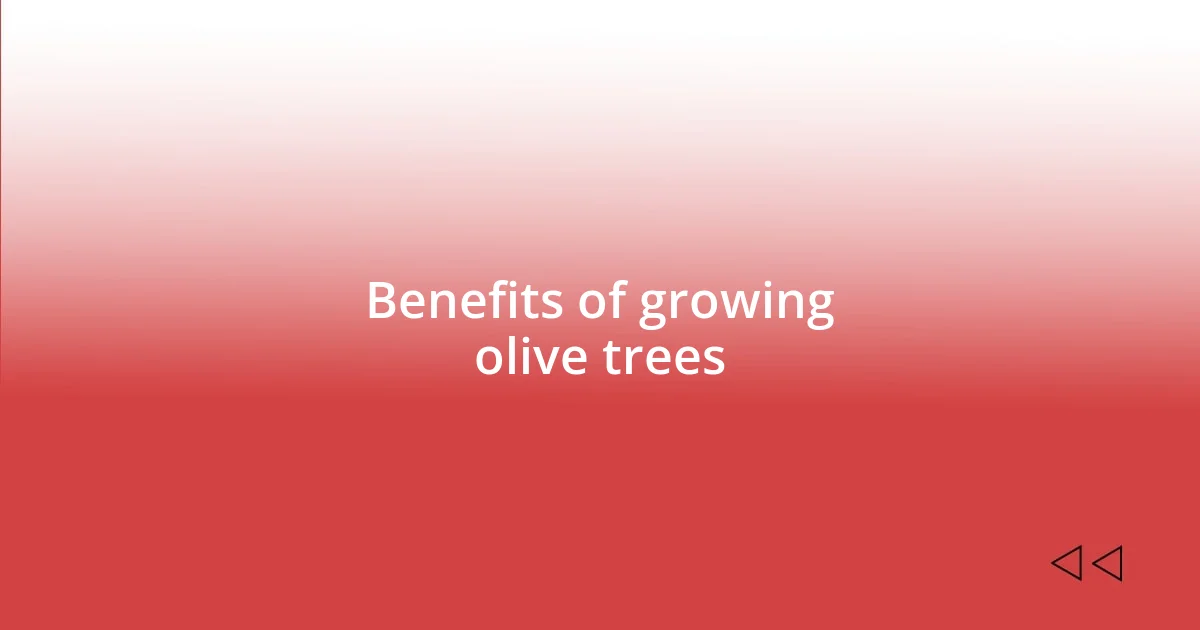Key takeaways:
- Olive trees are remarkably resilient, thriving for over a thousand years and adapting to harsh conditions.
- Growing olive trees offers long-term food production, adaptability to various soil types, and enhances garden aesthetics.
- Harvesting olives requires careful timing for optimal ripeness and involves a satisfying process of collecting them by hand.

Unique features of olive trees
One unique feature of olive trees that never ceases to amaze me is their remarkable resilience. I remember visiting an ancient olive grove on a trip to Greece, where some trees were over a thousand years old, yet they still bore fruit! It took me a moment to grasp how tenacious these trees are, surviving droughts, harsh winds, and even fires. Isn’t it incredible to think about how they’ve stood the test of time, even thriving in less-than-ideal conditions?
The gnarled trunks and silvery leaves are another distinctive characteristic that draws me in. Each twist and turn in the bark tells a story of years gone by. I often find myself running my fingers along the rough surface, feeling a connection to nature’s history. Have you ever stopped to admire the intricate patterns formed over decades? It’s both humbling and awe-inspiring.
Then there’s the beauty of the olive flowers, which are tiny yet utterly enchanting. When I first spotted them, I was taken by surprise; they seemed almost ethereal amidst the foliage. It’s fascinating how something so small can play a pivotal role in such a vital process—the production of olives. I’ve come to appreciate how the subtle details can sometimes create the most profound impacts, don’t you think?

Benefits of growing olive trees
Growing olive trees comes with a treasure trove of benefits that I’ve truly come to appreciate. For starters, they can produce olives for decades, providing a long-term source of food. I recall the excitement of harvesting my first batch of olives; the joy of enjoying your homegrown produce that you’ve nurtured is a feeling like no other.
Another remarkable benefit is their ability to adapt to various soil types. I’ve noticed how my trees flourish even in poorer soils, which has made me rethink my gardening approach entirely. It’s wonderful to see how these resilient trees thrive, definitely making them a smart choice for anyone looking to grow something beautiful yet manageable.
Beyond the tangible rewards, olive trees bring a serene beauty to your landscape. I often find myself sitting under their sprawling branches, soaking in the tranquility they impart to my garden. Watching the sunlight filter through the leaves brings a sense of peace that’s hard to find elsewhere; it’s a reminder of the simple joys of nature.
| Benefit | Description |
|---|---|
| Long-term Production | Olive trees can produce olives for decades, providing a continuous food source. |
| Adaptability | They thrive in various soil types, even in less favorable conditions. |
| Aesthetic Value | Olive trees enhance garden beauty and offer a tranquil environment. |

How to harvest olives
When it comes to harvesting olives, timing is everything. I vividly remember my first olive harvest; the joy was palpable, but I learned quickly that choosing the right moment makes a world of difference. You want to pick the olives when they are just starting to turn from green to a purplish hue, which indicates optimal ripeness for flavor. Have you ever tasted olives too early? It’s a lesson in patience.
The actual process of harvesting can be physical work, but it’s oddly satisfying. I typically use a combination of hand-picking and a light shake of the branches. Picture this: standing underneath a tree, feeling the cool breeze as olives rain down like tiny gems. It’s a simple pleasure to collect them in baskets, each one bursting with the promise of fresh oil or brined goodies. Isn’t there something delightful about that direct connection from tree to table?
After gathering the olives, it’s crucial to keep them safe and fresh until you process them. I learned the hard way that leaving them out too long might affect their taste and quality. For me, the excitement doesn’t end with the harvest; it builds as each batch turns into something delicious. Have you ever felt that anticipation when you know a culinary adventure awaits? It’s all part of the olive journey!















